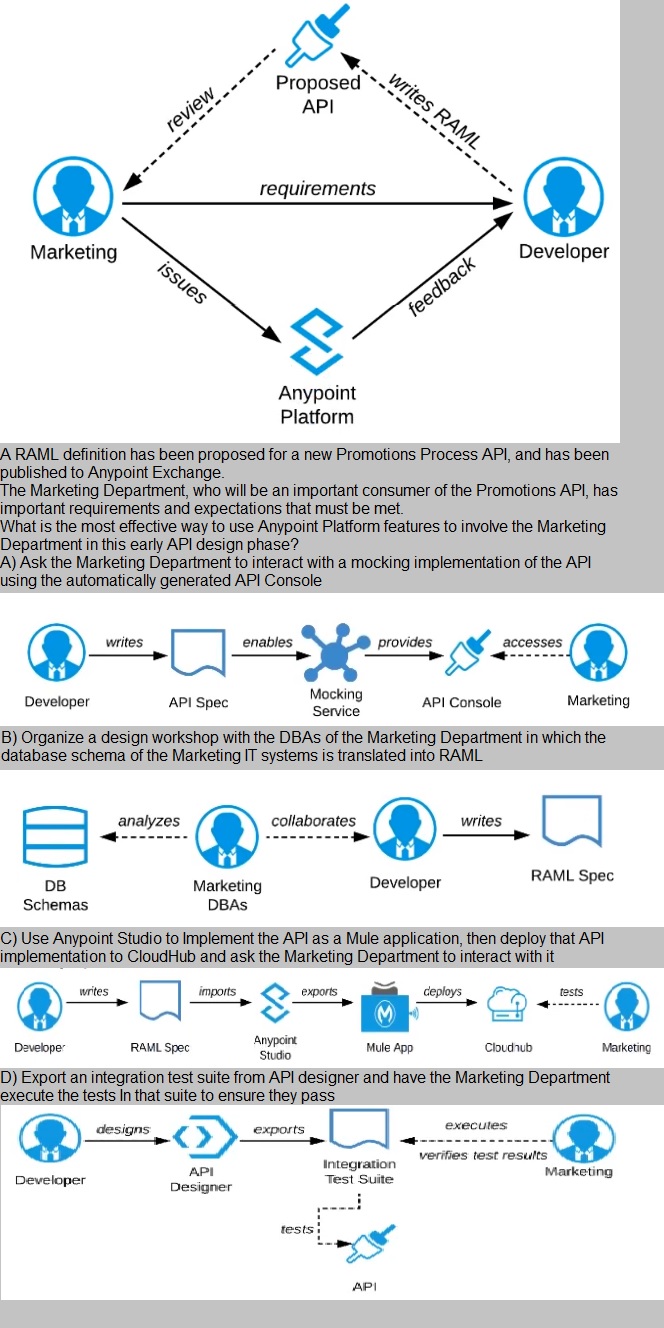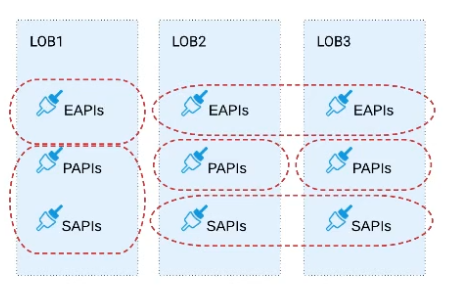Which component monitors APIs and endpoints at scheduled intervals, receives reports about whether tests pass or fail, and displays statistics about API and endpoint performance?
A. API Analytics
B. Anypoint Monitoring dashboards
C. APT Functional Monitoring
D. Anypoint Runtime Manager alerts
Explanation:
An API implementation is deployed to CloudHub. What conditions can be alerted on using the default Anypoint Platform functionality, where the alert conditions depend on the API invocations to an API implementation?
A. When the API invocations are sent directly to the internal DNS record of the API implementation
B. When the API invocations are not over-a- secure TLS/SSL communication channel
C. When the APL invecations originate from a geography different than the API
D. When the number of API invocations are below a threshold
Refer to the exhibit.
A.
Option A
B.
Option B
C.
Option C
D.
Option D
Option A
Explanation: Explanation
Correct Answer: Ask the Marketing Department to interact with a mocking implementation
of the API using the automatically generated API Console.
*****************************************
As per MuleSoft's IT Operating Model:
>> API consumers need NOT wait until the full API implementation is ready.
>> NO technical test-suites needs to be shared with end users to interact with APIs.
>> Anypoint Platform offers a mocking capability on all the published API specifications to
Anypoint Exchange which also will be rich in documentation covering all details of API
functionalities and working nature.
>> No needs of arranging days of workshops with end users for feedback.
API consumers can use Anypoint Exchange features on the platform and interact with the
API using its mocking feature. The feedback can be shared quickly on the same to
incorporate any changes.
A company requires Mule applications deployed to CloudHub to be isolated between nonproduction
and production environments. This is so Mule applications deployed to nonproduction
environments can only access backend systems running in their customerhosted
non-production environment, and so Mule applications deployed to production
environments can only access backend systems running in their customer-hosted
production environment. How does MuleSoft recommend modifying Mule applications,
configuring environments, or changing infrastructure to support this type of perenvironment
isolation between Mule applications and backend systems?
A.
Modify properties of Mule applications deployed to the production Anypoint Platform
environments to prevent access from non-production Mule applications
B.
Configure firewall rules in the infrastructure inside each customer-hosted environment so
that only IP addresses from the corresponding Anypoint Platform environments are allowed
to communicate with corresponding backend systems
C.
Create non-production and production environments in different Anypoint Platform
business groups
D.
Create separate Anypoint VPCs for non-production and production environments, then configure connections to the backend systems in the corresponding customer-hosted
environments
Create separate Anypoint VPCs for non-production and production environments, then configure connections to the backend systems in the corresponding customer-hosted
environments
Explanation: Explanation
Correct Answer: Create separate Anypoint VPCs for non-production and production
environments, then configure connections to the backend systems in the corresponding
customer-hosted environments.
*****************************************
>> Creating different Business Groups does NOT make any difference w.r.t accessing the
non-prod and prod customer-hosted environments. Still they will be accessing from both
Business Groups unless process network restrictions are put in place.
>> We need to modify or couple the Mule Application Implementations with the
environment. In fact, we should never implements application coupled with environments
by binding them in the properties. Only basic things like endpoint URL etc should be
bundled in properties but not environment level access restrictions.
>> IP addresses on CloudHub are dynamic until unless a special static addresses are
assigned. So it is not possible to setup firewall rules in customer-hosted infrastrcture. More
over, even if static IP addresses are assigned, there could be 100s of applications running
on cloudhub and setting up rules for all of them would be a hectic task, non-maintainable
and definitely got a good practice.
>> The best practice recommended by Mulesoft (In fact any cloud provider), is to have
your Anypoint VPCs seperated for Prod and Non-Prod and perform the VPC peering or
VPN tunneling for these Anypoint VPCs to respective Prod and Non-Prod customer-hosted
environment networks.
: https://docs.mulesoft.com/runtime-manager/virtual-private-cloud
Bottom of Form
Top of Form
What is true about automating interactions with Anypoint Platform using tools such as Anypoint Platform REST APIs, Anypoint CU, or the Mule Maven plugin?
A.
Access to Anypoint Platform APIs and Anypoint CU can be controlled separately through the roles and permissions in Anypoint Platform, so that specific users can get access to Anypoint CLI white others get access to the platform APIs
B.
Anypoint Platform APIs can ONLY automate interactions with CloudHub, while the Mule Maven plugin is required for deployment to customer-hosted Mule runtimes
C.
By default, the Anypoint CLI and Mule Maven plugin are NOT included in the Mule runtime, so are NOT available to be used by deployed Mule applications
D.
API policies can be applied to the Anypoint Platform APIs so that ONLY certain LOBs have access to specific functions
By default, the Anypoint CLI and Mule Maven plugin are NOT included in the Mule runtime, so are NOT available to be used by deployed Mule applications
Explanation: Explanation
Correct Answer: By default, the Anypoint CLI and Mule Maven plugin are NOT included in
the Mule runtime, so are NOT available to be used by deployed Mule applications
*****************************************
>> We CANNOT apply API policies to the Anypoint Platform APIs like we can do on our
custom written API instances. So, option suggesting this is FALSE.
>> Anypoint Platform APIs can be used for automating interactions with both CloudHub
and customer-hosted Mule runtimes. Not JUST the CloudHub. So, option opposing this is
FALSE.
>> Mule Maven plugin is NOT mandatory for deployment to customer-hosted Mule
runtimes. It just helps your CI/CD to have smoother automation. But not a compulsory
requirement to deploy. So, option opposing this is FALSE.
>> We DO NOT have any such special roles and permissions on the platform to separately
control access for some users to have Anypoint CLI and others to have Anypoint Platform
APIs. With proper general roles/permissions (API Owner, Cloudhub Admin etc..), one can
use any of the options (Anypoint CLI or Platform APIs). So, option suggesting this is
FALSE.
Only TRUE statement given in the choices is that - Anypoint CLI and Mule Maven plugin
are NOT included in the Mule runtime, so are NOT available to be used by deployed Mule
applications.
Maven is part of Studio or you can use other Maven installation for development.
CLI is convenience only. It is one of many ways how to install app to the runtime.
These are definitely NOT part of anything except your process of deployment or
automation.
A European company has customers all across Europe, and the IT department is migrating from an older platform to MuleSoft. The main requirements are that the new platform should allow redeployments with zero downtime and deployment of applications to multiple runtime versions, provide security and speed, and utilize Anypoint MQ as the message service. Which runtime plane should the company select based on the requirements without additional network configuration?
A. Runtime Fabric on VMs / Bare Metal for the runtime plane
B. Customer-hosted runtime plane
C. MuleSoft-hosted runtime plane (CloudHub)
D. Anypoint Runtime Fabric on Self-Managed Kubernetes for the runtime plane
Explanation:
For a European company with requirements such as zero-downtime
redeployment, deployment to multiple runtime versions, secure and fast
performance, and the use of Anypoint MQ without additional network configuration,
CloudHub is the best choice for the following reasons:
Refer to the exhibit.

A. Option A
B. Option B
C. Option C
D. Option D
Explanation:
An organization has implemented a Customer Address API to retrieve customer address
information. This API has been deployed to multiple environments and has been configured
to enforce client IDs everywhere.
A developer is writing a client application to allow a user to update their address. The
developer has found the Customer Address API in Anypoint Exchange and wants to use it
in their client application.
What step of gaining access to the API can be performed automatically by Anypoint
Platform?
A.
Approve the client application request for the chosen SLA tier
B.
Request access to the appropriate API Instances deployed to multiple environments using the client application's credentials
C.
Modify the client application to call the API using the client application's credentials
D.
Create a new application in Anypoint Exchange for requesting access to the API
Approve the client application request for the chosen SLA tier
Explanation: Explanation
Correct Answer: Approve the client application request for the chosen SLA tier
*****************************************
>> Only approving the client application request for the chosen SLA tier can be automated
>> Rest of the provided options are not valid
Reference: https://docs.mulesoft.com/api-manager/2.x/defining-sla-tiers#defining-a-tier
| Page 1 out of 19 Pages |